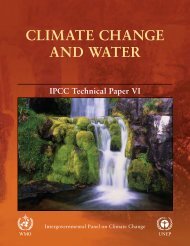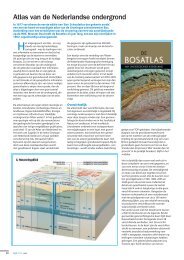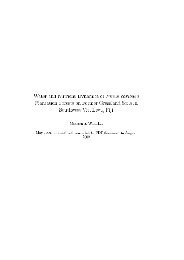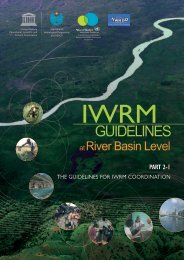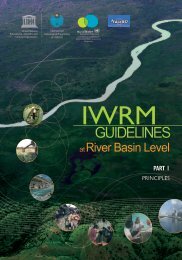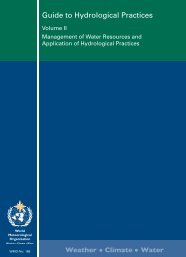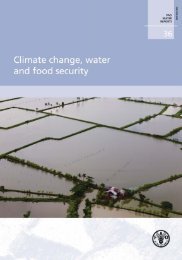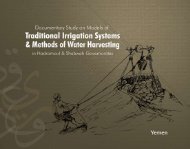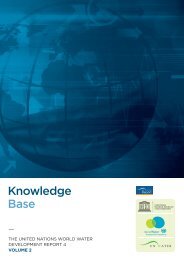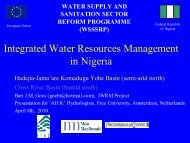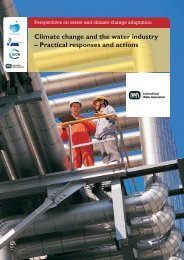Non-renewable groundwater resources: a ... - unesdoc - Unesco
Non-renewable groundwater resources: a ... - unesdoc - Unesco
Non-renewable groundwater resources: a ... - unesdoc - Unesco
- No tags were found...
Create successful ePaper yourself
Turn your PDF publications into a flip-book with our unique Google optimized e-Paper software.
CHAPTER 1 ■ CONCEPT AND IMPORTANCE OF NON-RENEWABLE RESOURCESmentary basins of the semi-arid and arid regions. It is here also that <strong>renewable</strong> water <strong>resources</strong>are most scarce and the interest in such aquifer systems is greatest.Elsewhere, aquifers containing non-<strong>renewable</strong> <strong>groundwater</strong> <strong>resources</strong> are present in humidregions, but their distribution is more limited and their importance is much less, except wheredeep highly-confined aquifers are being tapped by high-yielding artesian overflowing waterwells.Additionally the expansion of the permafrost in some arctic areas can hinder or eliminateaquifer recharge and this can also result in the occurrence of aquifers with non-<strong>renewable</strong><strong>groundwater</strong> <strong>resources</strong> (for example, some sedimentary basins in Russian Siberia, northwesternCanada and Alaska.Current utilisation of non-<strong>renewable</strong> <strong>resources</strong>Aquifer systems with recognised non-<strong>renewable</strong> <strong>resources</strong>, where significant <strong>groundwater</strong> mininghas already taken place, are located principally in North Africa and the Arabian Peninsula(Table 4). In these regions large aquifer systems with non-<strong>renewable</strong> <strong>groundwater</strong> <strong>resources</strong>are often transboundary in political distribution, a factor which imposes special conditions andparticular constraints on resource management.On the basis of available statistics (undoubtedly incomplete) the global mining of <strong>groundwater</strong>is currently put at some 27,000 Mm3/a, and if this figure is compared to the current totalrate of <strong>groundwater</strong> exploitation, provisionally put at 670,000 Mm 3 /a (Shiklomanov, 1998),the proportion derived from <strong>groundwater</strong> mining is 4%. This production is mainly concentratedin Saudi Arabia and Libya, who have some 77% of the estimated total world extraction ofTable 4. Exploitation of non-<strong>renewable</strong> <strong>groundwater</strong> <strong>resources</strong>COUNTRYYEAR(S)OF ESTIMATEGROUNDWATER (Mm 3 /a)Share of demand * Total use <strong>Non</strong>-<strong>renewable</strong>Algeria (2000) 54% 2,600 1,680Saudi Arabia 1999 (1996) 85% 21,000 17,800Bahrain 1999 (1996) 63% 258 90Egypt 1999 (2002) 7% 4,850 900UAE 1999 (1996) 70% 900 1,570Jordan 1999 (1994) 39% 486 170Libya 1999 95% 4,280 3,014Oman 1999 (1991) 89% 1,644 240Qatar 1999 (1996) 53% 185 150Tunisia 2000 59% 1,670 460Yemen 1999 (1994) 62% 2,200 700Note:* Proportion of total actual water demand met from <strong>groundwater</strong>.Source: Based on Margat (1995, 1998, 2004), UN-FAO (1997), UN-ECSWA (1999).19





